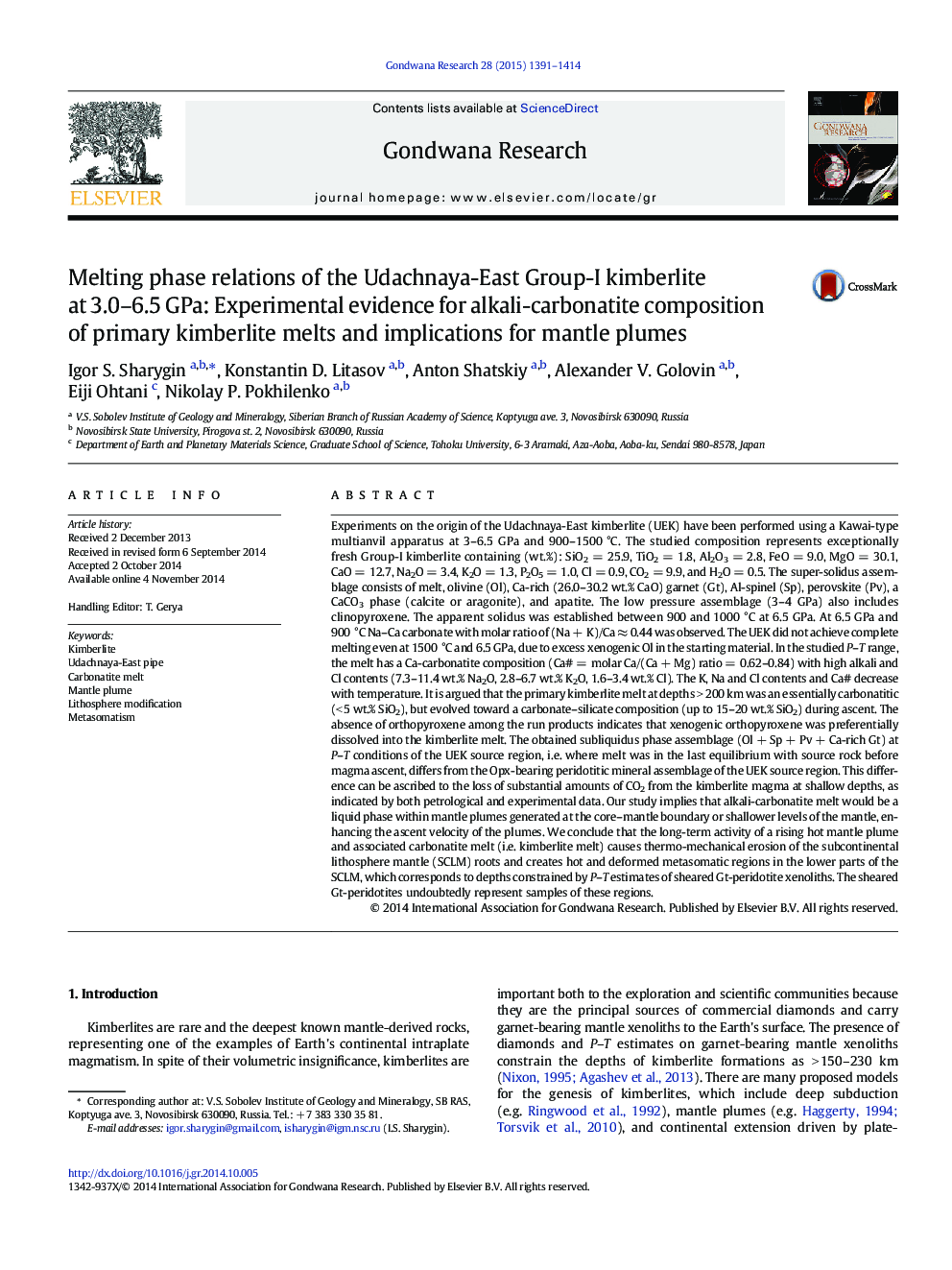| کد مقاله | کد نشریه | سال انتشار | مقاله انگلیسی | نسخه تمام متن |
|---|---|---|---|---|
| 4726698 | 1356343 | 2015 | 24 صفحه PDF | دانلود رایگان |

• Exceptionally fresh Udachnaya-East kimberlites represent original composition of Group-I kimberlite rocks.
• Primary kimberlite melt was an alkali-rich dolomitic carbonatite (< 5 wt.% SiO2).
• Ascending melt evolved to a carbonate–silicate composition via dissolution of xenogenic silicates.
Experiments on the origin of the Udachnaya-East kimberlite (UEK) have been performed using a Kawai-type multianvil apparatus at 3–6.5 GPa and 900–1500 °C. The studied composition represents exceptionally fresh Group-I kimberlite containing (wt.%): SiO2 = 25.9, TiO2 = 1.8, Al2O3 = 2.8, FeO = 9.0, MgO = 30.1, CaO = 12.7, Na2O = 3.4, K2O = 1.3, P2O5 = 1.0, Cl = 0.9, CO2 = 9.9, and H2O = 0.5. The super-solidus assemblage consists of melt, olivine (Ol), Ca-rich (26.0–30.2 wt.% CaO) garnet (Gt), Al-spinel (Sp), perovskite (Pv), a CaCO3 phase (calcite or aragonite), and apatite. The low pressure assemblage (3–4 GPa) also includes clinopyroxene. The apparent solidus was established between 900 and 1000 °C at 6.5 GPa. At 6.5 GPa and 900 °C Na–Ca carbonate with molar ratio of (Na + K)/Ca ≈ 0.44 was observed. The UEK did not achieve complete melting even at 1500 °C and 6.5 GPa, due to excess xenogenic Ol in the starting material. In the studied P–T range, the melt has a Ca-carbonatite composition (Ca# = molar Ca/(Ca + Mg) ratio = 0.62–0.84) with high alkali and Cl contents (7.3–11.4 wt.% Na2O, 2.8–6.7 wt.% K2O, 1.6–3.4 wt.% Cl). The K, Na and Cl contents and Ca# decrease with temperature. It is argued that the primary kimberlite melt at depths > 200 km was an essentially carbonatitic (< 5 wt.% SiO2), but evolved toward a carbonate–silicate composition (up to 15–20 wt.% SiO2) during ascent. The absence of orthopyroxene among the run products indicates that xenogenic orthopyroxene was preferentially dissolved into the kimberlite melt. The obtained subliquidus phase assemblage (Ol + Sp + Pv + Ca-rich Gt) at P–T conditions of the UEK source region, i.e. where melt was in the last equilibrium with source rock before magma ascent, differs from the Opx-bearing peridotitic mineral assemblage of the UEK source region. This difference can be ascribed to the loss of substantial amounts of CO2 from the kimberlite magma at shallow depths, as indicated by both petrological and experimental data. Our study implies that alkali-carbonatite melt would be a liquid phase within mantle plumes generated at the core–mantle boundary or shallower levels of the mantle, enhancing the ascent velocity of the plumes. We conclude that the long-term activity of a rising hot mantle plume and associated carbonatite melt (i.e. kimberlite melt) causes thermo-mechanical erosion of the subcontinental lithosphere mantle (SCLM) roots and creates hot and deformed metasomatic regions in the lower parts of the SCLM, which corresponds to depths constrained by P–T estimates of sheared Gt-peridotite xenoliths. The sheared Gt-peridotites undoubtedly represent samples of these regions.
Figure optionsDownload as PowerPoint slide
Journal: Gondwana Research - Volume 28, Issue 4, December 2015, Pages 1391–1414